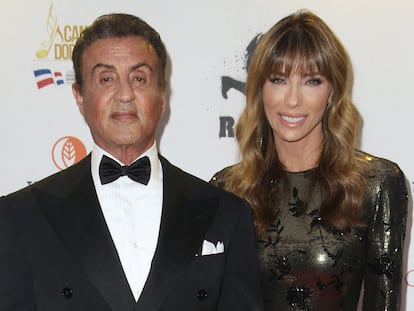Sylvester Stallone: A legend of classic action cinema becomes a modern superhero
At 76, the star of ‘Rocky’ and ‘Rambo’ produces and features in ‘Samaritan,’ where he gives in to the digital conventions of the superhero genre
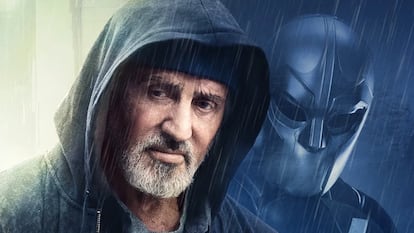
After a mysterious and solitary garbage man protects a boy from some thugs, the kid starts chasing him to beg him to teach him how to fight like him. This could be the plot of a classic Sylvester Stallone movie, but we are in 2022 and this garbage man is not just any man: the boy actually thinks he could be Samaritan, a superhero who had disappeared 20 years earlier. The movie Samaritan, released on Friday, August 26 on Amazon Prime Video, is the latest attempt by the star of Rocky (1976) to appeal to young audiences in the midst of the Marvel era. It is far from his first one: he is also present in the Marvel Cinematic Universe (MCU), playing Stakar in the second installment of Guardians of the Galaxy (2017), as well as the DC Universe, voicing Nanaue the Shark in The Suicide Squad (2016). Also, in the 1990s, before the cinematic superhero boom, he tested the waters with Judge Dredd (1995), one of the great failures of his career at the time.
What is interesting about Samaritan – which Stallone himself produced through his Balboa Productions company – is that, along with the superhero component, there is also an aura of the old street vigilante stories and the social element that has always characterized the actor’s work: a neighborhood environment and a broken family lie at the heart of the narrative. Stallone has taken the superheroes to his own turf. Another peculiarity is that this is not exactly an adaptation, as the previous comic is a derivative made by the author of the script, Bragi F. Schut, before the movie was produced.
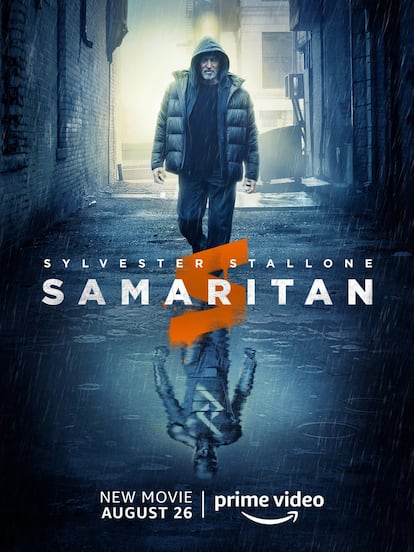
Stallone, who has also been in the news for his divorce from Jennifer Flavin, his wife for 25 years, has shown a keen eye for understanding trends throughout his career. Although the Judge Dredd experiment did not work, the move made sense in a context where Tim Burton’s two Batmans (1989 and 1992) had triumphed, and where projects of a Spider-Man by James Cameron and a Superman by Burton and Nicolas Cage had been announced (albeit never carried out). That superheroes were a potential niche for action stars was something that Arnold Schwarzenegger also saw, his great competitor at the time, who was interested in the same role. And the actor of Italian descent was, above all, one of the stars who best anticipated 1980s nostalgia: he revisited the iconic characters of Rocky Balboa in 2006 and John Rambo in 2008 and, with them, brought about his own commercial comeback.
The conviction with which the actor has bet on superheroes in recent years is not something unusual. Wrestlers turned actors, like Dwayne Johnson (whom we will see in Black Adam in October), John Cena (Peacemaker) or Dave Bautista (Drax in the Marvel sagas of Guardians of the Galaxy, Thor and The Avengers) have become part of the ecosystem, filling the screen with musclemen. Vin Diesel, the voice of Groot, also in the MCU, took a stab at it in 2020 with Bloodshot, and female action stars like Angelina Jolie and Michelle Yeoh have also put their martial arts skills to use in Eternals (2021) and Shang-Chi and the Legend of the Ten Rings (2021).
The contrasting opinion is provided by Jason Statham, who in 2015 eloquently expressed to the Italian outlet I 400 Calci his lack of interest in this kind of cinema: “I could take my grandma and put her in a cape, and they’ll put her on a green screen and they’ll have stunt doubles come in and do all the action. Anybody can do it.”
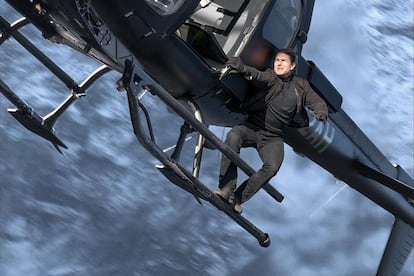
Risking it all for the show
Can someone who was already a star in the 1980s play a superhero more than three decades later? This is where the stuntmen come in. “It is normal for actors like Statham to see their movements limited by the techniques with which these films are shot,” says Spanish film specialist Ángel Plana. “But others are potentiated, especially if we talk about people as old as Stallone or Harrison Ford.” In Samaritan, where the action is pure fantasy and the thugs get thrashed, the main holds and the most complex moves that Stallone, 76, is seen doing, take place with him wearing a hooded coat and with his back to us; although, in some other moments, he can be seen actually making an effort to perform some choreography. “When you don’t see the actor’s face, it’s not him, it’s the stuntman. Everyone is obviously going to have to fake it if the superhero needs to make a 100-foot jump or fly, but, in general, modern systems have made their work much easier,” explains Plana.
An actor that is popular for his unconditional involvement in the physical plane is Tom Cruise, who has never been in a superhero movie. During the tribute that was paid to him at the last edition of the Cannes Film Festival, where he was awarded the Palme d’Or of Honor, Cruise explained his eagerness to take part in the risky scenes by stating that he always thinks “of the public and their experience.” To avoid as many digital effects as possible, the star of Top Gun: Maverick learned (and taught his co-stars) how to fly a plane, he said on The Graham Norton Show. This allowed him to put the camera in places where you usually can’t. This mindset is his trademark: Cruise has his own stunt coordinator, Wade Eastwood, with whom he has worked for a decade.
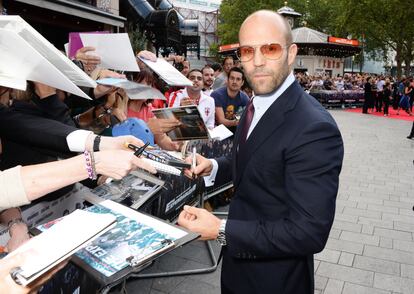
“Tom Cruise sells very well the image of an actor who doesn’t need a stunt double, but he is actually one of those with the most stunt doubles,” explains Plana. “He’s very good, because he’s not afraid and he can do a lot of the stunts, which helps the stuntmen do a better job. He can skid, spin, shoot off at full speed... but then the specialist is almost always the one who will reach the end, the one who will be in the accident or drive terrifically.”
Plana – who has a long career in Spanish cinema and heads a school of specialists that bears his own name – does not believe that the predominance of superhero movies, or the intensification of digital effects, must necessarily depreciate the authentic show, the action or the contribution of his guild. He believes that modern techniques can contribute to improving the level of what is being offered, keeping in mind that “at some point it is better not to use so much digital assistance, and return to pure action.” As an example of a healthy coexistence between great physical feats and CGI in modern action cinema, he cites a clear reference: the Fast & Furious saga, with Vin Diesel, Jason Statham, Dwayne Johnson or John Cena. “They are proof that spectacularity is not being lost. You see the movies and there is nothing more impressive. And it’s thanks to all the technology that’s behind them.”
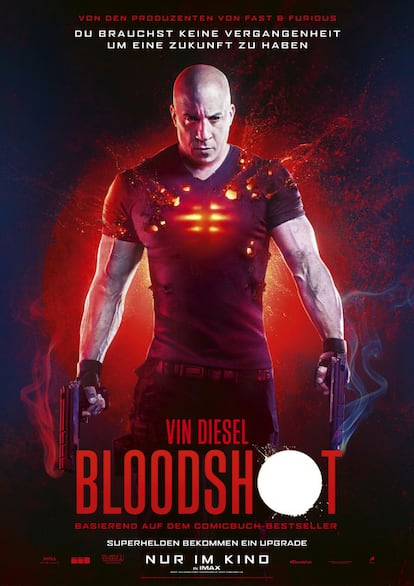
Puedes seguir ICON en Facebook, Twitter, Instagram,o suscribirte aquí a la Newsletter.
Tu suscripción se está usando en otro dispositivo
¿Quieres añadir otro usuario a tu suscripción?
Si continúas leyendo en este dispositivo, no se podrá leer en el otro.
FlechaTu suscripción se está usando en otro dispositivo y solo puedes acceder a EL PAÍS desde un dispositivo a la vez.
Si quieres compartir tu cuenta, cambia tu suscripción a la modalidad Premium, así podrás añadir otro usuario. Cada uno accederá con su propia cuenta de email, lo que os permitirá personalizar vuestra experiencia en EL PAÍS.
¿Tienes una suscripción de empresa? Accede aquí para contratar más cuentas.
En el caso de no saber quién está usando tu cuenta, te recomendamos cambiar tu contraseña aquí.
Si decides continuar compartiendo tu cuenta, este mensaje se mostrará en tu dispositivo y en el de la otra persona que está usando tu cuenta de forma indefinida, afectando a tu experiencia de lectura. Puedes consultar aquí los términos y condiciones de la suscripción digital.
More information
Archived In
Últimas noticias
Most viewed
- Reinhard Genzel, Nobel laureate in physics: ‘One-minute videos will never give you the truth’
- Oona Chaplin: ‘I told James Cameron that I was living in a treehouse and starting a permaculture project with a friend’
- Pablo Escobar’s hippos: A serious environmental problem, 40 years on
- Chevy Chase, the beloved comedian who was a monster off camera: ‘Not everyone hated him, just the people who’ve worked with him’
- Why we lost the habit of sleeping in two segments and how that changed our sense of time

